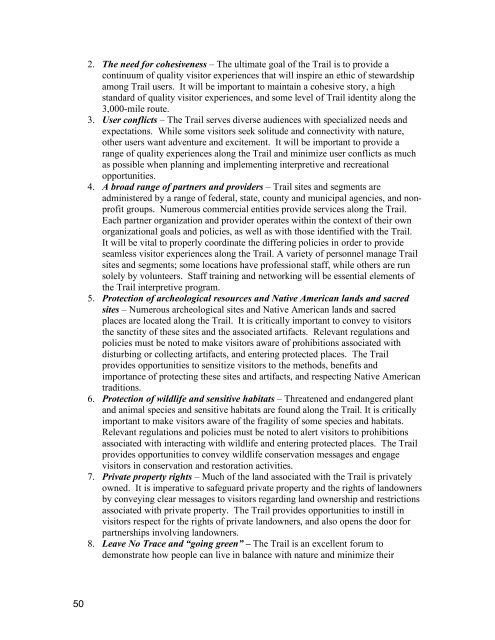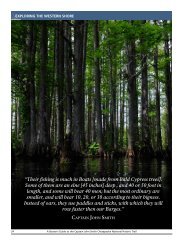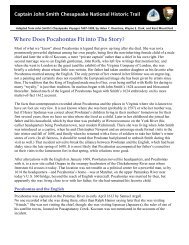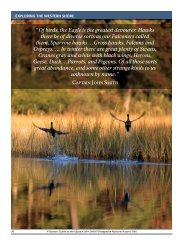Draft Interpretive Plan Join the adventure! - Captain John Smith ...
Draft Interpretive Plan Join the adventure! - Captain John Smith ...
Draft Interpretive Plan Join the adventure! - Captain John Smith ...
You also want an ePaper? Increase the reach of your titles
YUMPU automatically turns print PDFs into web optimized ePapers that Google loves.
50<br />
2. The need for cohesiveness – The ultimate goal of <strong>the</strong> Trail is to provide a<br />
continuum of quality visitor experiences that will inspire an ethic of stewardship<br />
among Trail users. It will be important to maintain a cohesive story, a high<br />
standard of quality visitor experiences, and some level of Trail identity along <strong>the</strong><br />
3,000-mile route.<br />
3. User conflicts – The Trail serves diverse audiences with specialized needs and<br />
expectations. While some visitors seek solitude and connectivity with nature,<br />
o<strong>the</strong>r users want <strong>adventure</strong> and excitement. It will be important to provide a<br />
range of quality experiences along <strong>the</strong> Trail and minimize user conflicts as much<br />
as possible when planning and implementing interpretive and recreational<br />
opportunities.<br />
4. A broad range of partners and providers – Trail sites and segments are<br />
administered by a range of federal, state, county and municipal agencies, and nonprofit<br />
groups. Numerous commercial entities provide services along <strong>the</strong> Trail.<br />
Each partner organization and provider operates within <strong>the</strong> context of <strong>the</strong>ir own<br />
organizational goals and policies, as well as with those identified with <strong>the</strong> Trail.<br />
It will be vital to properly coordinate <strong>the</strong> differing policies in order to provide<br />
seamless visitor experiences along <strong>the</strong> Trail. A variety of personnel manage Trail<br />
sites and segments; some locations have professional staff, while o<strong>the</strong>rs are run<br />
solely by volunteers. Staff training and networking will be essential elements of<br />
<strong>the</strong> Trail interpretive program.<br />
5. Protection of archeological resources and Native American lands and sacred<br />
sites – Numerous archeological sites and Native American lands and sacred<br />
places are located along <strong>the</strong> Trail. It is critically important to convey to visitors<br />
<strong>the</strong> sanctity of <strong>the</strong>se sites and <strong>the</strong> associated artifacts. Relevant regulations and<br />
policies must be noted to make visitors aware of prohibitions associated with<br />
disturbing or collecting artifacts, and entering protected places. The Trail<br />
provides opportunities to sensitize visitors to <strong>the</strong> methods, benefits and<br />
importance of protecting <strong>the</strong>se sites and artifacts, and respecting Native American<br />
traditions.<br />
6. Protection of wildlife and sensitive habitats – Threatened and endangered plant<br />
and animal species and sensitive habitats are found along <strong>the</strong> Trail. It is critically<br />
important to make visitors aware of <strong>the</strong> fragility of some species and habitats.<br />
Relevant regulations and policies must be noted to alert visitors to prohibitions<br />
associated with interacting with wildlife and entering protected places. The Trail<br />
provides opportunities to convey wildlife conservation messages and engage<br />
visitors in conservation and restoration activities.<br />
7. Private property rights – Much of <strong>the</strong> land associated with <strong>the</strong> Trail is privately<br />
owned. It is imperative to safeguard private property and <strong>the</strong> rights of landowners<br />
by conveying clear messages to visitors regarding land ownership and restrictions<br />
associated with private property. The Trail provides opportunities to instill in<br />
visitors respect for <strong>the</strong> rights of private landowners, and also opens <strong>the</strong> door for<br />
partnerships involving landowners.<br />
8. Leave No Trace and “going green” – The Trail is an excellent forum to<br />
demonstrate how people can live in balance with nature and minimize <strong>the</strong>ir








